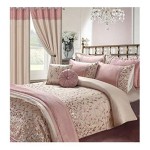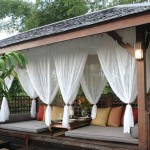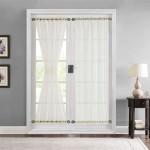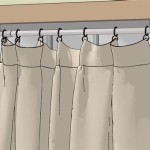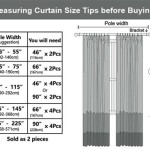Curtains and Blinds for Patio Doors: A Comprehensive Guide
Patio doors serve as a crucial transition between indoor and outdoor living spaces, offering natural light and easy access to patios, decks, and backyards. However, the expansive glass area of patio doors presents unique challenges in terms of privacy, light control, energy efficiency, and aesthetics. Selecting the appropriate window treatments is essential for maximizing the functionality and visual appeal of these doors. Curtains and blinds are two primary options, each offering distinct advantages and disadvantages depending on the specific needs and preferences of the homeowner.
This article provides a comprehensive overview of the various types of curtains and blinds suitable for patio doors, exploring their features, benefits, and drawbacks. It aims to equip homeowners with the knowledge necessary to make informed decisions when choosing window coverings for their patio doors, ensuring optimal privacy, light management, insulation, and aesthetic harmony within their living spaces.
Understanding the Requirements for Patio Door Window Treatments
Before delving into the specifics of curtains and blinds, it is crucial to understand the key requirements that patio door window treatments must address. These requirements often differ from those for standard windows due to the size and functionality of patio doors.
Privacy: Patio doors, particularly those facing neighboring properties or public spaces, require effective privacy solutions. The large glass area can make interiors easily visible from the outside, compromising the occupants' sense of seclusion. Window treatments must provide adequate coverage and opacity to prevent unwanted views into the home.
Light Control: The amount of sunlight entering through patio doors can significantly impact the comfort and usability of the adjacent living space. Excessive sunlight can cause glare, fade furniture, and increase indoor temperatures. Window treatments should offer various levels of light control, allowing homeowners to adjust the amount of natural light entering the room according to their needs. This may involve options for filtering, diffusing, or completely blocking sunlight.
Energy Efficiency: Patio doors can be a significant source of heat loss in winter and heat gain in summer, impacting energy bills and overall comfort. Window treatments can play a crucial role in improving energy efficiency by providing insulation and reducing heat transfer. Insulating curtains and blinds can help to keep the interior temperature stable, reducing the need for heating and cooling.
Ease of Operation: Patio doors are frequently used for access to outdoor areas, and the window treatments should not hinder this functionality. The opening and closing mechanism should be easy to operate, allowing for quick adjustments and unobstructed access to the patio or deck. Consider the ease of drawing curtains or adjusting blinds multiple times a day.
Aesthetics: The chosen window treatments should complement the overall décor of the room and enhance the visual appeal of the patio door. The style, color, and texture of the curtains or blinds should harmonize with the existing furniture, flooring, and wall colors. The window treatments should also be proportionate to the size of the patio door, creating a balanced and aesthetically pleasing look.
Durability: Considering the frequency of use and exposure to sunlight, patio door window treatments should be durable and resistant to wear and tear. The materials used should be able to withstand regular operation and exposure to UV rays without fading, cracking, or deteriorating prematurely. High-quality materials and construction are essential for ensuring longevity and maintaining the appearance of the window treatments over time.
Curtains for Patio Doors: Styles, Materials, and Considerations
Curtains offer a versatile and aesthetically pleasing solution for covering patio doors. They come in a wide variety of styles, materials, and colors, allowing homeowners to customize their window treatments to match their personal preferences and décor. However, selecting the right type of curtains requires careful consideration of the specific needs and challenges presented by patio doors.
Types of Curtains: Several types of curtains are suitable for patio doors, each offering different levels of light control, privacy, and insulation.
Sheer Curtains: Sheer curtains are made of lightweight, translucent fabrics that allow a significant amount of light to pass through. They provide minimal privacy but can soften the sunlight and add a delicate, airy feel to the room. Sheer curtains are often used in combination with other types of curtains or blinds to provide layered light control and privacy options.
Light-Filtering Curtains: Light-filtering curtains are made of semi-opaque fabrics that diffuse sunlight while still allowing some light to enter the room. They provide a moderate level of privacy and can help to reduce glare and soften the harshness of direct sunlight. These curtains are a good option for homeowners who want to maintain natural light while minimizing privacy concerns.
Room-Darkening Curtains: Room-darkening curtains are designed to block out most of the light entering the room, creating a darker and more comfortable environment. They are typically made of tightly woven fabrics or lined with a blackout material. Room-darkening curtains are ideal for bedrooms, home theaters, or any space where complete darkness is desired.
Blackout Curtains: Blackout curtains offer the highest level of light blockage, completely preventing light from entering the room. They are typically made of multiple layers of fabric or lined with a thick, opaque material. Blackout curtains are ideal for bedrooms, nurseries, or any space where complete darkness is essential for sleep or other activities.
Insulated Curtains: Insulated curtains are designed to improve energy efficiency by reducing heat transfer through the patio door. They are typically made of multiple layers of fabric with a thermal lining that provides insulation. Insulated curtains can help to keep the interior temperature stable, reducing energy bills and improving overall comfort.
Materials: The choice of curtain material significantly impacts its appearance, performance, and durability. Common curtain materials include:
Cotton: Cotton is a natural fiber that is soft, breathable, and easy to care for. Cotton curtains are a good option for creating a casual and comfortable atmosphere. However, cotton can be prone to fading and shrinking, so it is important to choose a high-quality cotton fabric.
Linen: Linen is another natural fiber that is known for its durability and elegant drape. Linen curtains have a slightly textured appearance that adds visual interest to the room. However, linen can be prone to wrinkling, so it may require ironing.
Polyester: Polyester is a synthetic fiber that is durable, wrinkle-resistant, and easy to care for. Polyester curtains are a good option for homeowners who want a low-maintenance window treatment.
Silk: Silk is a luxurious natural fiber that is known for its smooth texture and elegant sheen. Silk curtains add a touch of sophistication to the room. However, silk is delicate and requires professional cleaning.
Velvet: Velvet is a plush fabric that is known for its rich color and luxurious feel. Velvet curtains add warmth and elegance to the room. However, velvet can be heavy and difficult to clean.
Heading Styles: The heading style of the curtains affects their appearance and how they hang on the rod. Common heading styles include:
Rod Pocket: Rod pocket curtains have a sewn-in pocket at the top that slides onto the curtain rod. This is a simple and affordable heading style that is suitable for casual décor.
Grommet: Grommet curtains have metal rings sewn into the top that slide onto the curtain rod. This heading style creates a modern and streamlined look.
Pleated: Pleated curtains have folds that are sewn into the top of the curtain, creating a more formal and tailored look. Common pleat styles include pinch pleat, goblet pleat, and box pleat.
Tab Top: Tab top curtains have fabric loops sewn onto the top that hang from the curtain rod. This heading style creates a casual and relaxed look.
Blinds for Patio Doors: Types, Materials, and Functionality
Blinds offer a more structured and functional alternative to curtains for covering patio doors. They provide precise control over light and privacy and can be easily adjusted to suit different needs. However, selecting the right type of blinds requires careful consideration of the specific requirements of the patio door and the overall aesthetic of the room.
Types of Blinds: Several types of blinds are suitable for patio doors, each offering different levels of light control, privacy, and ease of operation.
Vertical Blinds: Vertical blinds consist of long, vertical slats that hang from a track. They are a popular choice for patio doors because they are easy to operate and provide excellent light control. Vertical blinds can be rotated to adjust the amount of light entering the room or drawn completely to the side to provide unobstructed access to the patio.
Horizontal Blinds: Horizontal blinds consist of horizontal slats that are connected by cords or tapes. They can be raised or lowered to control the amount of light entering the room and rotated to adjust the angle of the slats. While less common than vertical blinds for patio doors, they can be used effectively, especially in spaces where a more traditional look is desired.
Sliding Panel Blinds: Sliding panel blinds consist of large, flat panels of fabric or other materials that slide horizontally along a track. They are similar to Japanese shoji screens and offer a clean and modern look. Sliding panel blinds are a good option for covering large expanses of glass and can be customized with different fabrics and patterns.
Cellular Shades (Honeycomb Blinds): Cellular shades are made of a honeycomb-shaped fabric that traps air, providing excellent insulation. They are a good option for improving energy efficiency and reducing heat transfer through the patio door. Cellular shades can be raised or lowered to control the amount of light entering the room and are available in a variety of colors and opacities.
Materials: The choice of blind material significantly impacts its durability, appearance, and performance. Common blind materials include:
Vinyl: Vinyl blinds are a popular choice for their affordability, durability, and ease of cleaning. They are resistant to moisture and warping, making them a good option for bathrooms and kitchens. However, vinyl blinds can be less aesthetically appealing than other materials.
Wood: Wood blinds offer a natural and elegant look. They are available in a variety of wood species and finishes and can be stained or painted to match the décor of the room. However, wood blinds can be more expensive than other materials and require regular maintenance to prevent warping and cracking.
Faux Wood: Faux wood blinds are made of composite materials that mimic the look of real wood. They are more affordable than wood blinds and are resistant to moisture and warping. Faux wood blinds are a good option for homeowners who want the look of wood without the maintenance.
Aluminum: Aluminum blinds are durable, lightweight, and easy to clean. They are a good option for modern and industrial-style décor. However, aluminum blinds can be noisy and may not provide as much insulation as other materials.
Operating Mechanisms: The operating mechanism of the blinds affects their ease of use and functionality. Common operating mechanisms include:
Corded: Corded blinds have cords that are used to raise, lower, and tilt the slats. This is a traditional operating mechanism that is still widely used. However, cords can be a safety hazard for young children and pets.
Cordless: Cordless blinds have a mechanism that allows the slats to be raised and lowered without the use of cords. This is a safer option for homes with young children and pets.
Motorized: Motorized blinds can be operated with a remote control or a smart home system. This is a convenient option for homeowners who want to automate their window treatments or have difficulty reaching the blinds.
Key Considerations for Choosing Between Curtains and Blinds
The choice between curtains and blinds for patio doors depends on a variety of factors, including personal preferences, budget, and functional requirements. Here are some key considerations to help homeowners make the right decision:
Light Control: Consider the desired level of light control. Blinds generally offer more precise light control than curtains, as the slats can be adjusted to filter or block light as needed. Curtains offer more varied options through layering sheer and blackout fabrics.
Privacy: Assess privacy needs. Both curtains and blinds can provide privacy, but the level of privacy depends on the material and style. Room-darkening curtains and opaque blinds offer the highest level of privacy.
Energy Efficiency: Evaluate energy efficiency requirements. Insulated curtains and cellular shades offer the best energy efficiency by trapping air and reducing heat transfer.
Ease of Operation: Consider the ease of operation. Vertical blinds and sliding panel blinds are easy to operate for patio doors, while cordless or motorized options offer added convenience.
Aesthetics: Determine the desired aesthetic. Curtains offer a wider range of styles, colors, and textures, allowing for greater customization. Blinds offer a more structured and modern look.
Budget: Establish a budget. Curtains and blinds vary in price depending on the material, style, and operating mechanism. Consider the long-term cost of maintenance and replacement when making a decision.
By carefully considering these factors, homeowners can choose the window treatments that best meet their needs and enhance the beauty and functionality of their living spaces.

Sliding Glass Door Treatments Skyline Blinds For Doors

Choosing The Right Patio Door Treatments Pella Windows Doors

Sliding Glass Door Blinds Curtains On Long Island

Are Curtains Or Blinds Better For Sliding Doors Amanda Katherine Interiors

White Cordless Light Filtering 3 5 In Vertical Blind Kit For Sliding Door Or Window 78 W X 84 L 10793478804986 The Home

Sliding Panel Curtains Lovely White Waves Set Of 4 Vertical Blinds For Glass Doors Patio Closet Office Space Divider Etsy

Off White Sliding Glass Door Curtain Shade 1 Panel

Blinds Shades For Sliding Glass Doors The Blind Alley Bellevue Wa

Blinds For Patio Doors Sliders

Sliding Door Blinds Patio Window Treatments Blindsgalore

